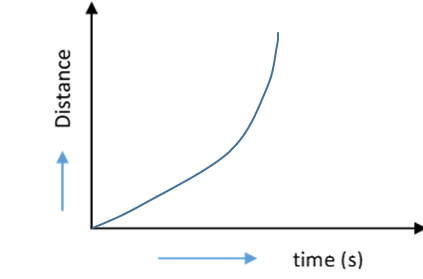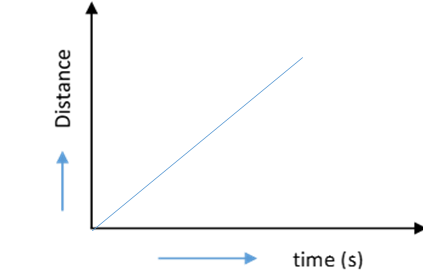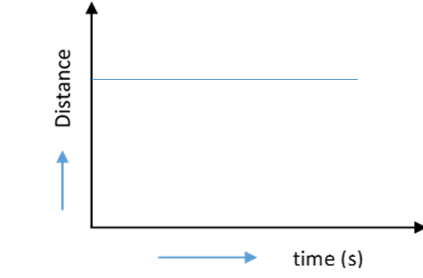
Which of the following distance time graph is representing the uniform accelerated motion of body:
A)

B)

C)

D) $\text{None of these}$
Answer
179.7k+ views
Hint: The distance time graph is representing the uniform accelerated motion of the body. Uniform Acceleration is derivative of v with respect to time. Here v is the velocity. When the body is provided constant acceleration, then it is uniformly accelerated motion. So, the constant external force is applied by the body, then direction of acceleration is change of velocity.
Complete step by step solution:
In accelerated motion the distance time graph is not a straight line. The graph is parabola when there is a uniform accelerated motion and Graph is irregular when there is non-uniform acceleration.
For a body to undergo an accelerated motion, the velocity time graph is a straight line. This means that the velocity will vary linearly with respect to time. However, the same is not true for displacement-time graphs. The displacement curve with respect to time will be most likely a parabolic curve. This is because the double derivative of displacement with respect to time is not zero.
Option A is correct. This is because change in distance per second is not constant. So, derivative will not be zero and uniform acceleration is performed.
Option B is incorrect. This is because change in distance per second is constant so if we take the derivative of this to get acceleration, the whole function becomes zero. Therefore, it is not representing the uniform acceleration in this case.
Option C is also incorrect. This is because distance is not changing with time so even the first derivative makes it zero. Therefore, there is no point in talking about acceleration.
When the slope of time is increasing, the velocity of the body also increases and so that the body is in accelerated motion.
Therefore, Option A is the correct answer.
Note: Velocity is the first derivative of distance with respect to time and acceleration is the second derivative of distance. So, neither displacement should be constant nor should change in displacement be constant.
Complete step by step solution:
In accelerated motion the distance time graph is not a straight line. The graph is parabola when there is a uniform accelerated motion and Graph is irregular when there is non-uniform acceleration.
For a body to undergo an accelerated motion, the velocity time graph is a straight line. This means that the velocity will vary linearly with respect to time. However, the same is not true for displacement-time graphs. The displacement curve with respect to time will be most likely a parabolic curve. This is because the double derivative of displacement with respect to time is not zero.
Option A is correct. This is because change in distance per second is not constant. So, derivative will not be zero and uniform acceleration is performed.
Option B is incorrect. This is because change in distance per second is constant so if we take the derivative of this to get acceleration, the whole function becomes zero. Therefore, it is not representing the uniform acceleration in this case.
Option C is also incorrect. This is because distance is not changing with time so even the first derivative makes it zero. Therefore, there is no point in talking about acceleration.
When the slope of time is increasing, the velocity of the body also increases and so that the body is in accelerated motion.
Therefore, Option A is the correct answer.
Note: Velocity is the first derivative of distance with respect to time and acceleration is the second derivative of distance. So, neither displacement should be constant nor should change in displacement be constant.
Recently Updated Pages
JEE Main 2023 (January 29th Shift 1) Maths Question Paper with Answer Key

JEE Main 2023 (January 25th Shift 1) Maths Question Paper with Answer Key

JEE Main 2023 (February 1st Shift 2) Maths Question Paper with Answer Key

JEE Main 2023 (January 29th Shift 2) Chemistry Question Paper with Answer Key

Uniform Acceleration - Definition, Equation, Examples, and FAQs

JEE Main 2023 (January 24th Shift 2) Chemistry Question Paper with Answer Key

Trending doubts
JEE Main 2025 Session 2: Application Form (Out), Exam Dates (Released), Eligibility, & More

JEE Main 2025: Derivation of Equation of Trajectory in Physics

Displacement-Time Graph and Velocity-Time Graph for JEE

Atomic Structure - Electrons, Protons, Neutrons and Atomic Models

Learn About Angle Of Deviation In Prism: JEE Main Physics 2025

What is Hybridisation in Chemistry?

Other Pages
NCERT Solutions For Class 11 Physics Chapter 2 Motion In A Straight Line - 2025-26

NCERT Solutions For Class 11 Physics Chapter 1 Units and Measurements - 2025-26

NCERT Solutions For Class 11 Physics Chapter 3 Motion In A Plane - 2025-26

JEE Advanced Marks vs Ranks 2025: Understanding Category-wise Qualifying Marks and Previous Year Cut-offs

Units And Measurements Class 11 Physics Chapter 1 CBSE Notes - 2025-26

Motion in a Straight Line Class 11 Physics Chapter 2 CBSE Notes - 2025-26




